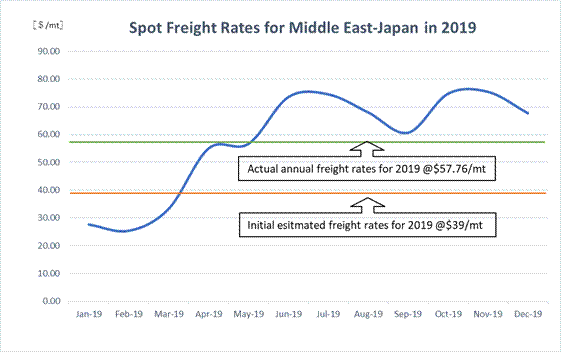|
Regarding freight rates for very large gas carriers (VLGCs) which convey liquified petroleum gas (LPG), some market sources gave views that the annual average rate for Middle East-Japan for 2020 might be in the mid $60's per metric ton (mt). This was because an index showing freight rates for the route was traded at this level in the futures market late last year. Further, for actual supply/demand of vessels, as transportation over long voyages such as US-India was expected to increase while limited new vessels were scheduled to launch into the market, a source from a ship broker said, "There are more bullish factors for the freight market than bearish factors".
Nevertheless, a source from a Japanese importer pointed out that freight rates in the futures market were unreliable. Many market sources recalled that at the end of 2018, in the futures market, the annual average of spot freight rate for Middle East-Japan had been traded at about $39/mt. However, freight rates showed volatility. In the beginning of the year, freight rates declined to about $20/mt owing to slack supply/demand of vessels and thereafter sharply rebounded as a number of vessels had to wait to load cargoes in the US Gulf Coast, causing vessel availability to decrease. With new routes developed for long voyages from the US to India and Indonesia, the annual average spot freight rates for 2019 assessed by Rim was $57.76/mt, much higher than the level where it was traded in the futures market at the end of 2018 (See graph below).

In 2020, with tighter regulations on sulfur for bunker oil by the International Maritime Organization (IMO) from January, bunker costs were seen to move much higher compared to last year. In addition, owing to cuts in crude oil output by oil producing countries, sources reckoned that LPG supply for cargoes of Middle East origin was likely to tighten and this would lead to an increase in cargo movements and chartering demand for long voyages as well as a rise in freight rates. If freight rates climbed sharply, however, there was possibility that LPG importers might refrain from buying LPG cargoes and spot chartering demand might recede as a result. Thus, another source from a Japanese importer said, "Similar to spot prices for LPG cargoes, we have no choice but to check supply/demand of vessels and price movements every day in order to accurately grasp market directions going forward."
|